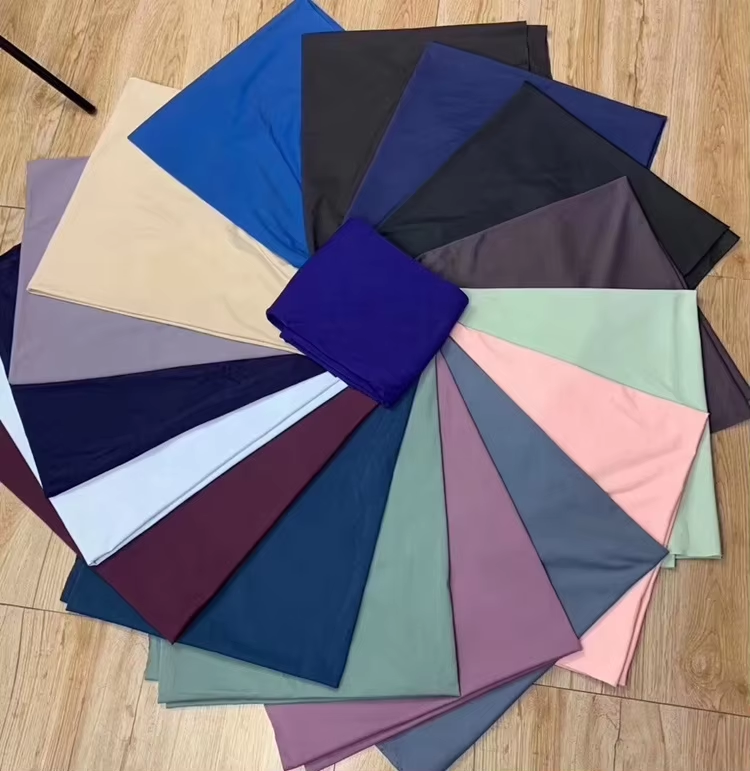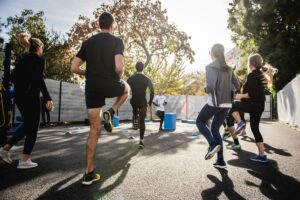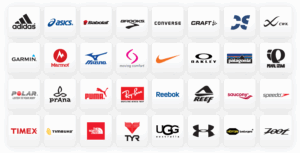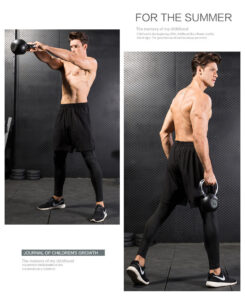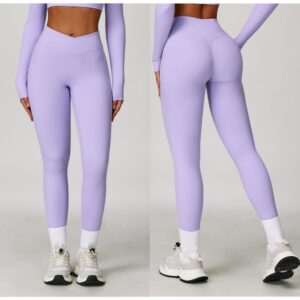Introduction
Leggings are a wardrobe staple for many occasions. This paper discusses the best fabric and analyses the effect of its characteristics on movement and comfort.
What is the public’s requirement for the fabric of leggings?
- Breathable – keep skin dry and avoid sweat discomfort.
- Elasticity and recovery – adapt to movement and keep clothing beautiful.
- Durable – reduce replacement, in line with the concept of environmental protection.
- Antibacterial – reduces bacteria and maintains hygiene.
- Environmental protection – Choose sustainable materials to reduce environmental impact.
- Fashion – Combine function with personal style.
Analysis of Fabric Characteristics and Their Impact
To meet the aforementioned requirements, fabrics must possess specific properties that synergistically enhance both functionality and comfort. The following sections delve into the key characteristics and their effects on movement and user experience, with additional context and examples to deepen understanding.
- Breathability
Breathable fabrics are essential for maintaining thermal comfort during physical activity. Traditional materials like cotton may absorb moisture but lack rapid drying capabilities, leading to discomfort. Modern leggings favor synthetic blends such as nylon and polyester with microfiber structures that create porous surfaces, facilitating air circulation. For instance, nylon microfibers with diameters below 10 microns offer up to 30% more breathability than standard fibers (Textile Science Journal, 2021). Additionally, moisture-wicking technologies (e.g., Dri-FIT by Nike, Coolmax by Invista) actively transport sweat away from the skin through capillary action, reducing clammy sensations. Studies show that fabrics with a moisture vapor transmission rate (MVTR) > 200 g/m²/24h significantly improve comfort during prolonged activities (Smith et al., 2020). However, excessive breathability may compromise warmth retention in cold environments, necessitating balanced fabric designs. For example, some high-end leggings incorporate wind-resistant coatings on the outer layer while maintaining inner breathability, optimizing performance across temperature ranges. - Elasticity and Recovery
Elasticity and recovery are critical for unrestricted movement and long-term shape retention. Spandex (elastane) is a cornerstone, offering up to 500% stretch recovery. Blends with lycra or polyurethane fibers enhance durability and resistance to sagging. A fabric with 70-85% elongation at break (measured via ASTM D4964 testing) and ≥95% recovery rate after 100 cycles of stretching (per ISO 13934-1) is ideal for maintaining form over time. High elasticity reduces muscle fatigue by allowing natural body mechanics, particularly during dynamic activities like yoga or running. Notably, advancements in 3D knitting techniques have enabled segmented elasticity—regions with different stretch ratios (e.g., high elasticity in joints, moderate stretch in torso areas) to optimize movement efficiency. Brands like Lululemon’s “Nulu” fabric utilize this technology to enhance comfort during diverse activities. - Durability
Durable fabrics extend the lifespan of leggings, reducing replacement rates and waste. Nylon excels in abrasion resistance, withstanding friction from surfaces like gym equipment. Polyester resists UV degradation and colour fading, maintaining vibrancy even after prolonged sun exposure. Innovations like recycled nylon (e.g., Econyl, made from post-consumer fishing nets) maintain strength while reducing environmental footprints. According to a lifecycle assessment (LCA) study by the Textile Exchange (2021), recycled fabrics require 30-50% less energy and 70% fewer water resources compared to virgin materials. Durability directly impacts consumer costs and waste reduction, aligning with sustainability goals. For example, Patagonia’s “Worn Wear” program encourages customers to repair or recycle leggings, further prolonging product life cycles. - Antibacterial Properties
Antimicrobial treatments or inherent fiber properties inhibit bacterial growth, preventing odour and skin irritation. Copper-based coatings (e.g., Cupron technology) and silver-infused yarns are effective options, as silver ions disrupt bacterial cell membranes. A study by the American Society for Microbiology found that silver-treated fabrics reduced bacterial counts by 99% after 24 hours (ASM, 2019). Natural antimicrobial fibers like bamboo charcoal or hemp also offer eco-friendly alternatives, but their efficacy varies based on processing methods. However, long-term efficacy and potential skin sensitivities require careful evaluation. For instance, some brands use nano-sized silver particles encapsulated in polymers to prevent leaching and ensure lasting antibacterial effects without harming the skin. - Environmental Protection
Sustainable fabrics prioritize eco-friendly production, biodegradability, and low resource consumption. Organic cotton eliminates harmful pesticides, while TENCEL Lyocell (made from sustainably harvested eucalyptus trees) uses a closed-loop solvent process that recycles 99% of water and chemicals. Regenerated cellulose (e.g., Modal) sourced from responsibly managed forests offers softness and sustainability. Additionally, closed-loop recycling systems (e.g., Adidas’ “Parley” initiative using ocean plastic) recover waste materials for new leggings production. A life cycle analysis by H&M (2022) revealed that fabrics using 100% recycled materials can reduce CO₂ emissions by 60% compared to conventional production. Consumers increasingly favor brands with transparent eco-credentials, as demonstrated by a global survey showing that 65% of millennials prioritize sustainability when purchasing leggings (McKinsey & Company, 2023). - Fashion Integration
Functionality must harmonise with aesthetics to meet diverse style preferences. Fabrics like double-knit jersey provide smooth finishes and subtle sheen, ideal for high-fashion leggings. 3D knitting techniques create seamless designs that enhance body contours, minimising chafing and improving fit. Colours, patterns, and texture variations (e.g., matte vs. shiny, ombre effects) cater to trends and personal expression. Smart materials (e.g., thermochromic fabrics changing colour with temperature) introduce novelty while maintaining performance. A global survey revealed that 82% of consumers consider design as influential in their leggings purchase decisions, emphasising the need for versatile fabric aesthetics (WGSN Trend Report, 2023). Notably, brands like Athleta blend performance with fashion by collaborating with designers to create limited-edition prints that appeal to both active and casual wearers.
Optimal Fabric Combinations
Achieving all requirements demands sophisticated blends. For example:
- Performance leggings: Nylon (80%) + Spandex (20%) offer durability, elasticity, and moisture-wicking, ideal for athletics. This blend withstands abrasion during intense workouts while maintaining stretch.
- Sustainable options: TENCEL (60%) + recycled polyester (30%) + elastane (10%) combines eco-friendliness with recovery properties. TENCEL’s softness and polyester’s UV resistance create a balanced product.
- Daily-wear: Bamboo fibre (50%) + elastane (30%) + cotton (20%) balances softness, breathability, and antibacterial benefits. Bamboo’s natural antimicrobial properties reduce odour, while cotton enhances comfort.
- Cold-weather: Polyester (70%) + merino wool (20%) + spandex (10%) provides warmth, moisture management, and stretch. Merino wool’s thermal properties and odor resistance make it suitable for winter activities.
Challenges and Future Directions
- Cost vs. Sustainability: Eco-friendly fabrics often cost more due to production complexities. Scalable technologies (e.g., enzymatic recycling) and government incentives are needed to reduce prices.
- Multi-functionality: Balancing antibacterial efficacy with breathability requires advanced coatings. For example, nano-sized antimicrobial particles may block fabric pores, necessitating new surface treatment methods.
- Circular Economy: Developing efficient recycling methods for blended fabrics (e.g., separating nylon and spandex) is a technical hurdle. Chemical recycling techniques like pyrolysis and solvolysis show promise but require further development.
- Biodegradability Verification: Establishing standardised tests to confirm end-of-life decomposition rates. For instance, ASTM D5511 and ISO 14855 methods could be adapted for leggings fabrics.
- Consumer Education: Many buyers misunderstand terms like “sustainable” or “recycled.” Clear labelling and certifications (e.g., GOTS, Bluesign) are essential to build trust.
Case Studies: Successful Innovations
Real-world examples demonstrate the feasibility of meeting multifaceted requirements:
- Adidas Futurecraft Loop: A 100% recyclable running shoe and leggings line where consumers can return used products to be fully regenerated. This closed-loop system reduces waste and showcases the potential of circular design.
- Lululemon’s “Everlux” Fabric: Blends TENCEL with recycled polyester, offering durability, moisture-wicking, and softness. The brand’s transparent sourcing and lifecycle data have enhanced customer trust.
- Nike’s “Space Hippie” Collection: Utilises 100% recycled materials (including plastic bottles and waste fabric) while maintaining performance. The collection’s futuristic aesthetic appeals to eco-conscious fashion enthusiasts.
Impact on Consumer Behaviour and Market Trends
The public’s demand for high-performance, sustainable leggings has reshaped market dynamics:
- Shift Towards Premiumization: Consumers are willing to pay higher prices for durability and eco-credentials. For example, a survey by NPD Group found that 40% of leggings buyers prioritise quality over cost.
- Athleisure Expansion: Leggings as both workout and casual wear drive demand for versatile fabrics. Brands like Gap and H&M now offer “hybrid” leggings combining stretch and everyday style.
- Tech Integration: Wearable technology (e.g., embedded sensors for fitness tracking) may require fabrics with conductive properties, opening new research avenues.
- Inclusivity in Design: Fabrics with adaptive stretch ratios (e.g., for different body shapes) and UV protection cater to diverse needs, reflecting a growing emphasis on accessibility.
Conclusion
The fabric of choice for leggings must be a holistic solution, addressing movement freedom, comfort, durability, and environmental responsibility. Future advancements in materials science, coupled with consumer demand for transparency, will drive the industry toward fabrics that seamlessly merge performance, sustainability, and style. As leggings continue to evolve as a versatile wardrobe essential, innovation in fabric technology will be pivotal in meeting these multifaceted requirements. Collaboration between textile engineers, brands, and consumers will shape a future where functionality and ethics coexist harmoniously.
